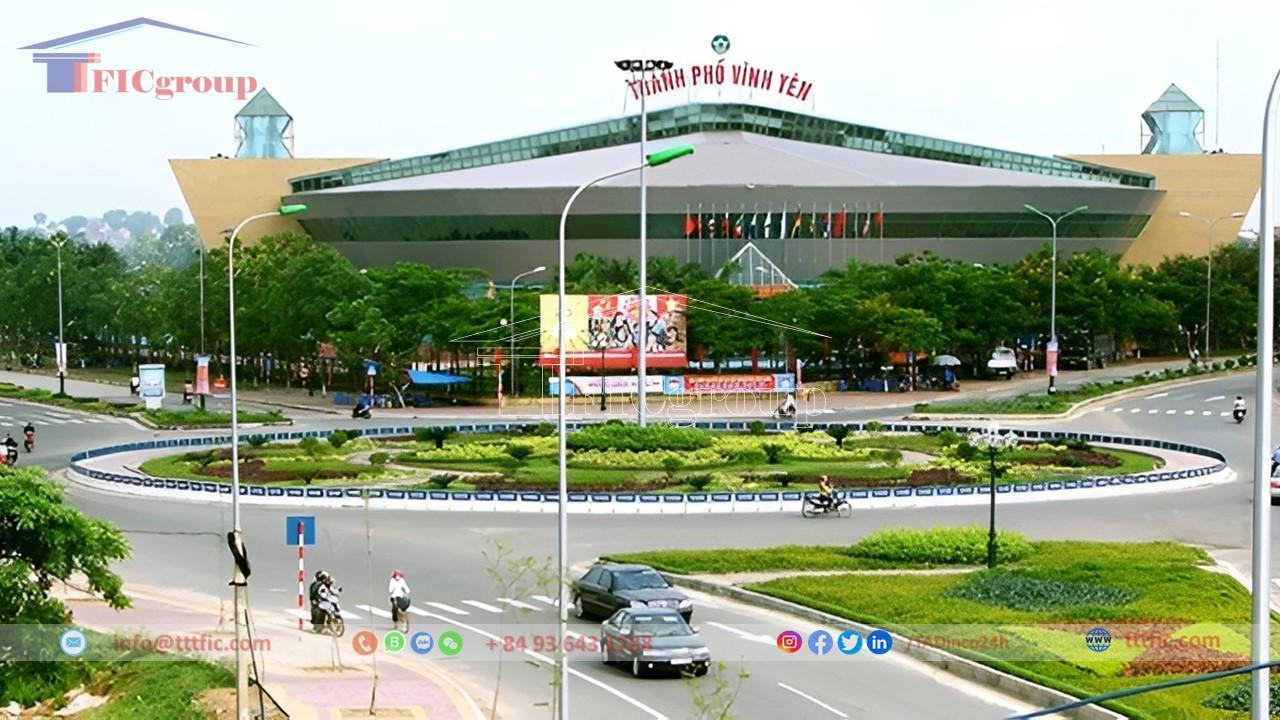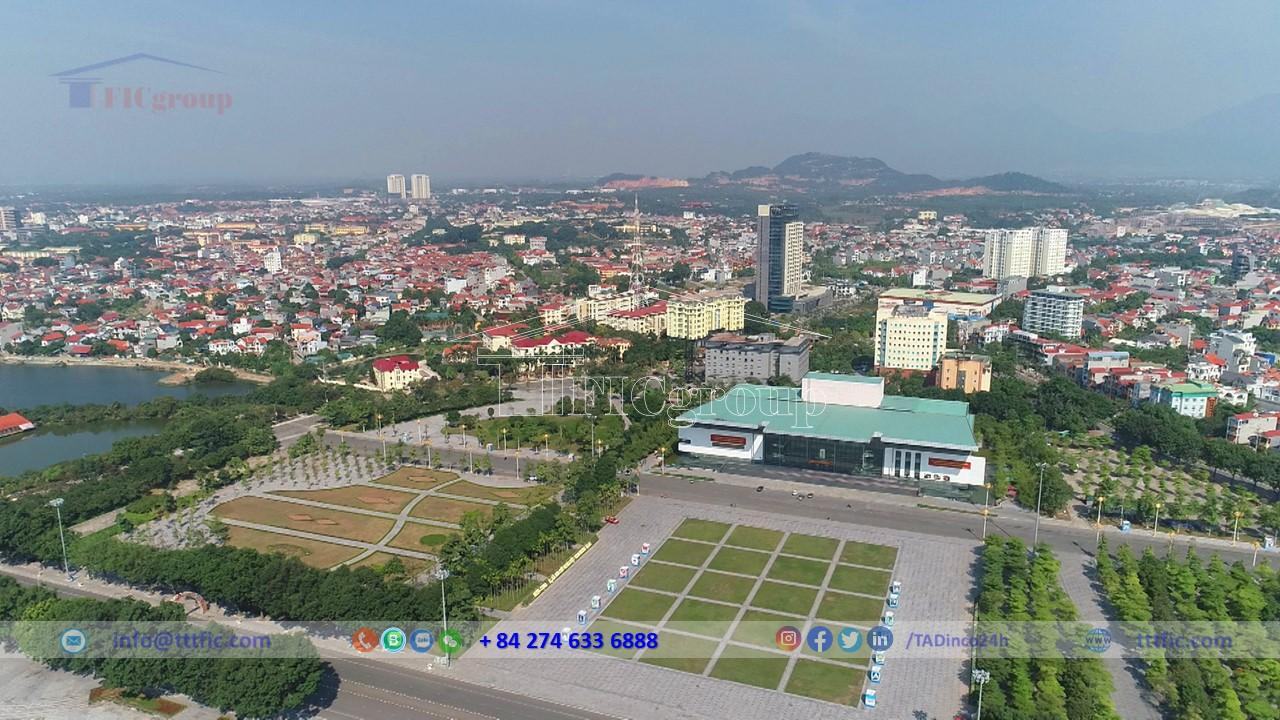Vinh Phuc Province:
Vinh Phuc province, a province in Vietnam, is situated in the center of the Northern region’s map. It falls within the planning for the Hanoi capital region and serves as a major economic hub in the North, known for its robust economic development.
In 2022, Vĩnh Phúc ranked as the 37th most populous administrative unit in Vietnam. It stood at the 13th position in terms of Gross Regional Domestic Product (GRDP) and the 9th position in terms of per capita GRDP. Additionally, it achieved the 31st spot in GRDP growth rate. The province’s population reached 1,204,300, with a GRDP of 152,178 billion Vietnamese Dong (equivalent to 6.62 billion USD), a per capita GRDP of 105 million Vietnamese Dong (equivalent to 5,494 USD), and a GRDP growth rate of 8.06%.
During the period of French temporary occupation from 1946 to 1954, the province was referred to as Vĩnh Phúc Yên. Previously, Vĩnh Phúc province encompassed Vĩnh Yên and Phúc Yên provinces. However, at present, the province consists solely of the land from the former Vĩnh Yên province and a portion of the land from the former Phúc Yên province, which is the city of Phúc Yên. The remaining districts of the former Phúc Yên province, namely Đông Anh, Yên Lãng (now Mê Linh district), Đa Phúc, and Kim Anh, merged into Hanoi city as part of Sóc Sơn district.
Geography of Vinh Phuc Province:
Geographical location:
Vĩnh Phúc province is located in the Red River Delta region, encompassing both lowland and mountainous areas. Its coordinates range from 21°35’15″N (on the Tam Đảo mountain range in Đạo Trù commune, Tam Đảo district) to 21°08’55″N (on the Hồng River in Đại Tự commune, Yên Lạc district); from 105°20’25″E (on the Lô River in Bạch Lưu commune, Sông Lô district) to 105°47’15″E (at an elevation of 238.65 meters in Ngọc Thanh commune, Phúc Yên city). Vĩnh Phúc lies in the upper region of the Red River Delta, in the middle of Northern Vietnam, with three ecological regions: the delta in the southern part of the province, the midland in the northern part, and the mountainous area in Tam Đảo district. The province has the following geographical features:
- To the north, it borders Thái Nguyên province (with the Tam Đảo mountain range as the boundary) and Tuyên Quang province.
- To the west, it borders Phú Thọ province, with the natural boundary being the Lô River.
- To the south and east, it borders the capital city of Hanoi, with the natural boundary being the Hồng River.
The extreme points of Vĩnh Phúc province are as follows:
- The northernmost point is in Đạo Trù commune, Tam Đảo district.
- The easternmost point is in Ngọc Thanh commune, Phúc Yên city.
- The westernmost point is in Bạch Lưu commune, Sông Lô district.
- The southernmost point is in Liên Châu commune, Yên Lạc district.
Due to its geographical location, Vĩnh Phúc exhibits distinct ecological regions: the delta, midland, and mountainous areas. It is adjacent to the capital city of Hanoi and is close to Nội Bài International Airport. The province has a convenient transportation system, including road, railway, and waterway networks along Vietnam’s economic development axis.
Vĩnh Phúc benefits from a relatively favorable transportation system, with National Highway 2, the Hanoi-Lào Cai Expressway, and the Hanoi-Lào Cai railway passing through its territory. The province is traversed by four main rivers: the Hồng River, the Lô River, the Phó Đáy River, and the Cà Lồ River. The Hồng River system serves as an important waterway, facilitating transportation for boats and vessels.
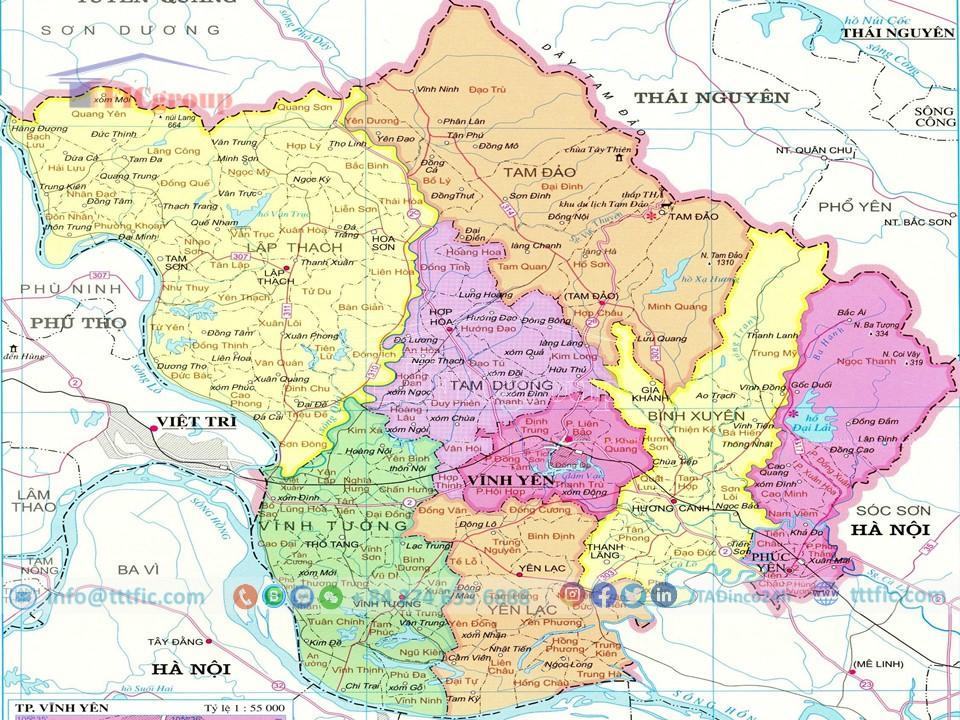
Climate:
The average annual temperature is 23.8°C, with the mountainous region of Tam Đảo at an elevation of 1,000 meters experiencing an average yearly temperature of 18.4°C. Tam Đảo has a lower average daily temperature compared to the Northern Delta region, at 5°C.
The average annual rainfall ranges from 1,400 mm to 1,600 mm. Specifically, the year-round average rainfall in the delta and midland areas at the Vĩnh Yên station is 1,323.8 mm, while in the mountainous area at the Tam Đảo station, it reaches 2,140 mm.
Rainfall distribution is uneven throughout the year, mainly concentrated from May to October, accounting for 80% of the total annual rainfall. The dry season spans from November to April of the following year, constituting only 20% of the total annual rainfall.
Sunshine hours: The average annual sunshine hours range from 1,400 to 1,800 hours. Among them, the months with the highest number of sunshine hours are June and July, while March has the fewest sunshine hours throughout the year.
Wind patterns: There are two main types of winds throughout the year: southeasterly winds blowing from April to September and northeasterly winds blowing from October to March of the following year.
Air humidity: The average annual humidity is 83%. Generally, there is not much variation in humidity between the mountainous, midland, and delta regions throughout the year. Two characteristic meteorological observation stations based on the terrain are Vĩnh Yên station (delta region) and Tam Đảo station (midland and mountainous area).
Evaporation rate: The average annual evaporation rate is 1,040 mm, with an average monthly evaporation rate from April to September at 107.58 mm, and from October to March of the following year at 71.72 mm.
Topography:
Vĩnh Phúc’s northern region is dominated by the Tam Đảo mountain range, extending over 30 kilometers from Đạo Trù commune (Tam Đảo) to Ngọc Thanh commune (Phúc Yên). The area is surrounded by the Red River and Lô River in the southwest, dividing the province into three distinct regions: the plain, hills, and low to medium mountains.
The plain region comprises 76 communes, wards, and townships, covering 46,800 hectares. It includes both old and new alluvial zones. The old alluvial zone, formed by sediments from major rivers like the Red River, Lô River, and Đáy River, encompasses the northern districts of Yên Lạc, Vĩnh Tường, and the southern districts of Tam Dương, Bình Xuyên. It was shaped during the Red River delta formation (Quaternary – Pleistocene). The new alluvial zone along the rivers in the southern districts of Sông Lô, Lập Thạch, Vĩnh Tường, Yên Lạc, and Bình Xuyên formed during the Quaternary – Holocene period. The alluvial soil in the plain region is fertile, ideal for agriculture.
The hilly region comprises 33 communes, wards, and townships, covering 24,900 hectares. It is favorable for cultivating industrial crops, fruits, flowers, and livestock farming, supporting the transition to increased food production.
The low and medium mountainous region covers 56,300 hectares, accounting for 46.3% of the province’s area. The mountainous terrain is complex, with numerous rivers and streams, providing advantages for concentrated industrial zones and eco-tourism. The Tam Đảo mountainous region includes a national forest area of 15,753 hectares..
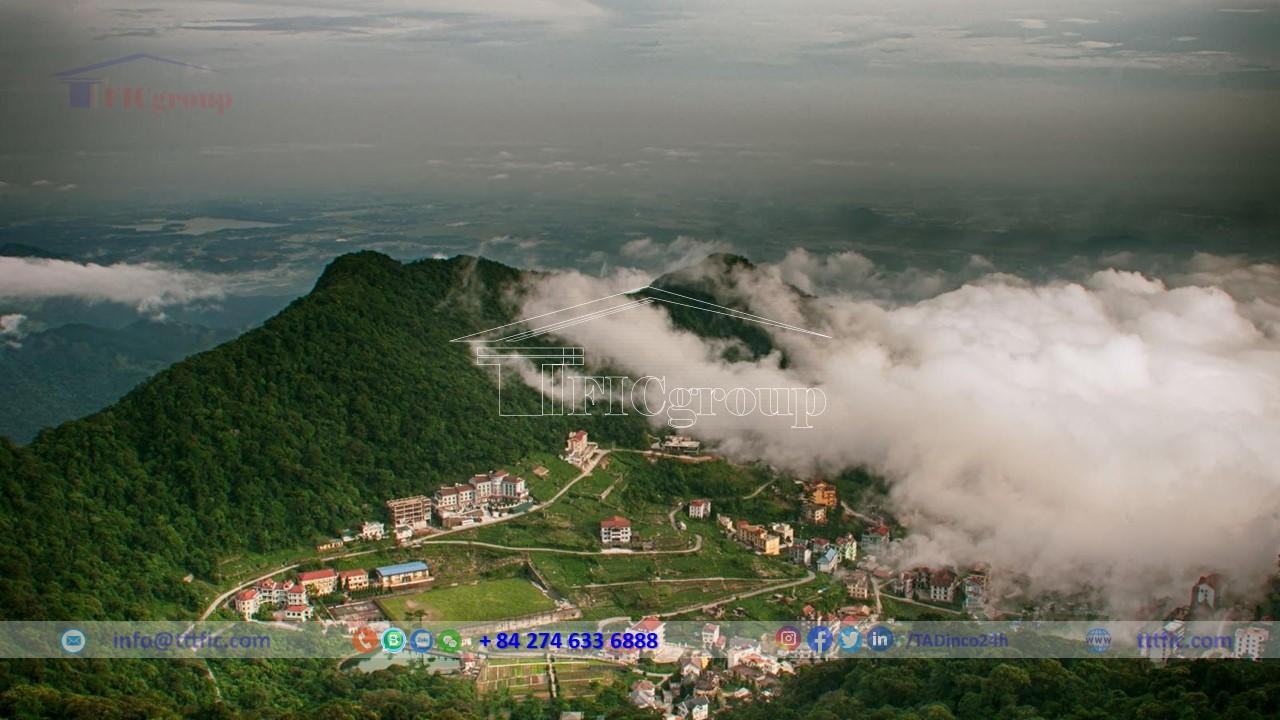
Economy of Vinh Phuc Province:
Vinh Phúc province’s GRDP in 2022 grew by 9.54%, the highest in the region. Livestock and manufacturing industries saw significant growth, while crop cultivation faced challenges. The service sector rebounded after pandemic-related difficulties. Overall, Vinh Phúc experienced positive economic growth in various sectors.
Agriculture, forestry, aquaculture:
Agriculture:
Crop:
In 2022, adverse weather conditions and high input costs affected crop cultivation in the province. Widespread flooding and crop damage led to decreased productivity and harvest yields. However, with collective efforts, the annual crop production managed to achieve satisfactory results, contributing to social well-being and food security. The total cultivated area slightly decreased by 0.02%, primarily due to a reduction in rice cultivation. The perennial crop sector focused on sustainable development and market alignment, leading to higher economic returns compared to traditional crops. However, challenges in adopting advanced agricultural practices persisted. The total area of perennial crops decreased by 1.28%, with fruit-bearing trees dominating. The winter crop planting progress for 2022-2023 faced setbacks due to heavy rainfall from a storm, affecting land preparation and reducing planting areas.
Breed:
Livestock production faced challenges due to small-scale and scattered operations, high feed prices, and unstable product prices, particularly for pork. However, in 2022, the introduction of new high-yielding animal breeds and advancements in livestock techniques and biosafety measures contributed to increased productivity and improved product quality. This led to significant development in livestock production, with notable growth in dairy milk, pork, poultry meat, and chicken eggs. While the livestock population experienced slight changes, including a decrease in buffalo and cattle herds but an increase in dairy cattle, pigs, and poultry, the overall meat output increased by 4.74% compared to the previous year, except for buffalo and cattle meat, which slightly declined.
Disease prevention measures, such as vaccination, disinfection, and environmental detoxification, were effectively implemented, resulting in only one outbreak of avian influenza and an outbreak of African swine fever in which appropriate containment measures were applied. No other dangerous infectious diseases, such as foot-and-mouth disease and blue-ear disease, occurred in the province.
Forestry:
In 2022, the province focused on planting new crops on 700 hectares, a 2.03% increase from 2021. The number of scattered planted trees reached 624.8 thousand, exceeding the planned target but decreasing compared to 2021 due to limited land availability. The estimated volume of harvested timber was 47,115.3 cubic meters, a 4.01% increase, while the harvested firewood volume reached 48,939 ste, an 8.11% decrease compared to 2021. Forest management and fire prevention efforts were prioritized by relevant agencies and forest owners. Throughout the year, there was one fire outbreak caused by bushfire in Ngoc Thanh commune, Phuc Yen city, and one forest fire incident in Lien Hoa commune, Lap Thach district, with a total burned area of 8.05 hectares. However, over 6 hectares were bushfire areas, not affecting timber trees, resulting in a confirmed loss of 2.0 hectares.
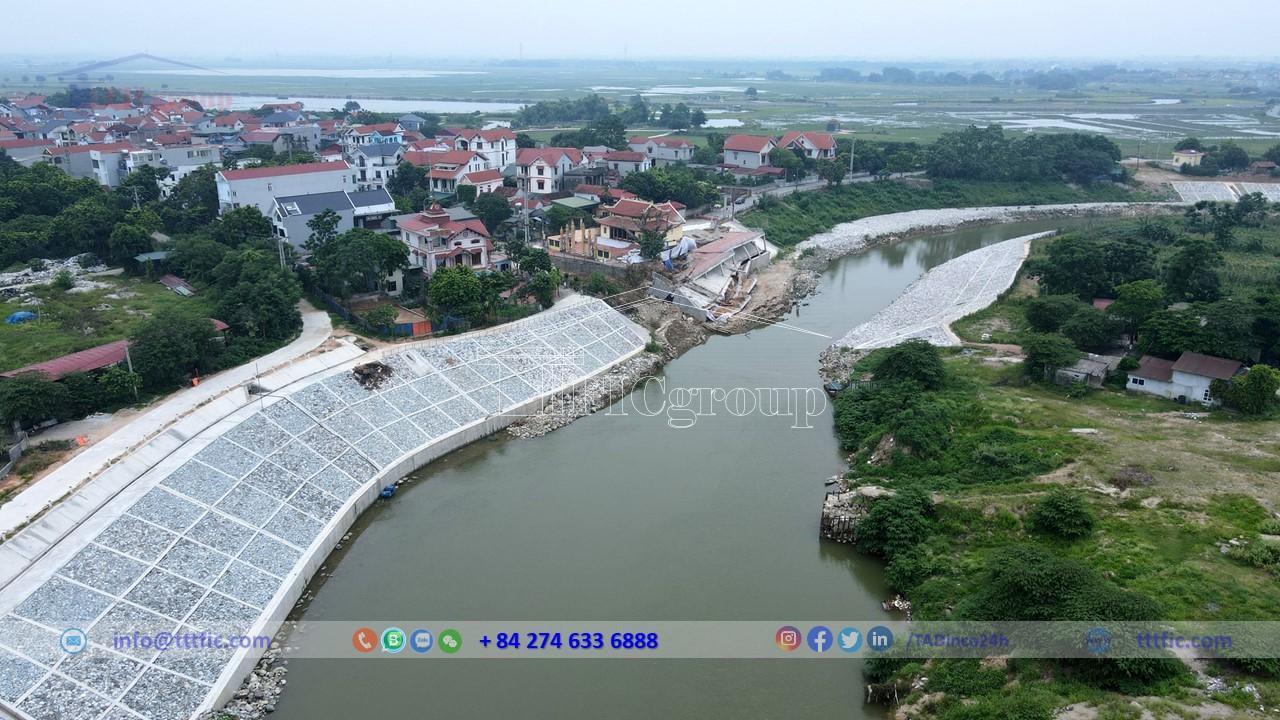
Aquaculture:
In 2022, the province’s aquaculture production faced difficulties, especially in the first six months when the Covid-19 outbreak surged after the Lunar New Year holiday nationwide. Transportation and goods circulation were restricted, leading to a decrease in seafood consumption. Additionally, heavy rainfall in May caused flooding and damage to many ponds and lakes, partially filling and damaging aquaculture areas, resulting in economic losses. However, stable and high market prices for seafood products allowed farmers to maintain production scale despite the challenges. Towards the end of the year, people actively cared for their fish stocks to ensure a sufficient supply for the upcoming Lunar New Year.
In 2022, the total seafood production reached an estimated 24,018.3 tons, a 1.57% increase. Domestic fishing production was estimated at 1,891 tons, a 0.12% increase, while aquaculture production reached 22.13 thousand tons, a 1.7% increase compared to the same period. The production of breeding stock in the year reached an estimated 3,109.5 million individuals, a 2.17% increase. The aquaculture area was estimated at 6,473.4 hectares, slightly lower than the previous year.
Industry:
In 2022, the province’s industrial production still faced some difficulties and challenges. There were localized shortages in the supply chain of materials and labor in certain industries. High prices of raw materials, transportation fees, and logistics costs increased production expenses. The number of new orders decreased due to tight monetary policies aimed at controlling inflation in traditional export markets like the US and EU. However, with the involvement of various levels of government, functional departments, and industrial enterprises within the province, proactive measures were taken to overcome challenges. They developed rational and flexible production plans, improved efficiency, and optimized production capacities. As a result, industrial production in the province experienced stable development and recorded significant growth compared to the same period, maintaining its role as the primary driver of overall economic growth in the province.
The industrial production index
The industrial production index (IIP) in 2022 showed significant growth, reaching its highest level since 2019. Throughout the year, the IIP increased by 15.83% compared to the same period, with consecutive quarterly growth rates: 14.46% in Q1, 17.30% in Q2, 14.03% in Q3, and 17.24% in Q4.
Among the secondary industries, 18 out of 24 sectors experienced increased production compared to the previous year, while 6 sectors witnessed a decline. Key industries continued to maintain a substantial growth rate, playing a vital role in the province’s industrial production. Electronic component manufacturing increased by 21.9%, motorcycle production grew by 16.52%, leather and related products manufacturing rose by 12.23%, textile manufacturing increased by 8.94%, and non-metallic mineral products manufacturing grew by 4.11%. Conversely, some industries experienced a decrease in production: other mining decreased by 40.34%, food processing decreased by 4.34%, paper and paper product manufacturing declined by 7.5%, metal production dropped by 5.75%, and other processing and manufacturing decreased by 0.9% compared to the same period.
Overall, the IIP in 2022 showcased strong growth, with several sectors driving the province’s industrial production, while some industries faced challenges and experienced a decline in production.
Product of industry:
In 2022, the province witnessed positive growth in its key industrial products, contributing to the overall growth of the industrial sector. Specifically, the estimated production of major industrial products showed an increase compared to the same period. These products include:
– Sports shoes: 14,686.2 thousand pairs, with a growth rate of 12.23%.
– Ceramic tiles: 115,795.7 thousand square meters, with a growth rate of 4.11%.
– Air conditioners: 13,464 units, with a growth rate of 9.29%.
– Various types of automobiles: 55,112 vehicles, with a growth rate of 1.16%.
– Motorcycles: 1,668,234 units, with a growth rate of 16.52%.
– Revenue from the production of electronic components: estimated at 222,333 billion VND, with a growth rate of 21.90% compared to 2021.
These products played a significant role in driving the industrial production and contributed positively to the overall growth of the industrial sector in the province in 2022.
Trade – service:
In 2022, the province effectively controlled the Covid-19 pandemic, leading to a smooth operation of trade and services. The economy and social activities experienced positive recovery and growth in most sectors.
Retail sales of goods and consumer services reached 67,023.1 billion VND, a 20.96% increase. Goods sales accounted for 59,636.6 billion VND, making up 88.98% of the total and increasing by 20.86%. All 12 groups of goods saw increased revenue, with petroleum, textiles, automobiles, household appliances, and cultural/educational products showing the highest growth.
Revenue from accommodation, dining, and travel services reached 4,774.2 billion VND, a 25.11% increase. Accommodation services generated 427.5 billion VND (57.26% increase), while dining services reached 4,219.7 billion VND (20.15% increase). Travel and tour services revenue surged to 127 billion VND (296.96% increase). Vinh Phuc’s tourism sector witnessed a strong recovery, with Tam Dao becoming the 7th National Tourist Area in Vietnam and receiving recognition from the World Travel Awards.
The revenue from consumer services totaled 2,612.3 billion VND, a 16.07% increase. Notable growth was observed in administrative/support services (excluding travel), education/training services, healthcare/social assistance services, artistic/recreational/entertainment services, and other services.
In transportation, revenue significantly grew, especially from the second quarter when Covid-19 was well controlled. Estimated transportation revenue reached 4,966.6 billion VND, a 35.38% increase. Passenger transportation revenue surged by 94.59%, while freight transportation revenue increased by 25.17%. Passenger and freight turnover also experienced significant growth.
Regarding import and export activities, the province’s export turnover reached 14,981 million USD, a 21.09% increase. Major exports included electronics, machinery/equipment/spare parts, motorcycles/motorcycle spare parts, textiles, and automotive components/spare parts. Import turnover reached 13,703 million USD, a 16.42% increase. Electronics, machinery/equipment/spare parts, motorcycles/motorcycle spare parts, and automotive components/spare parts were the main imports.
These figures reflect the province’s successful recovery and growth in various sectors during 2022.
Social:
Residential:
Vinh Phuc province had a total population of 1,151,154 people on April 1, 2019, with 573,621 males (accounting for 49.83%) and 577,533 females (50.17%).
As a result, Vinh Phuc ranked 37th out of 63 provinces and cities in terms of population. Over the past 10 years, the province’s population has increased by three ranks, reaching 40th in 2019, with an additional 151,368 people. The average annual population growth rate from 2009 to 2019 was 1.41%, higher than the national average of 1.14%.
Regarding population density, Vinh Phuc province ranked 10th out of 63 provinces and cities. In 2019, the population density was 932 people per square kilometer, an increase of 120 people per square kilometer compared to 2009. In contrast, the national population density was 290 people per square kilometer, with a growth of only 31 people per square kilometer since 2009.
The male population in Vinh Phuc currently accounts for 49.83% of the total population. The gender distribution in the province is gradually approaching a balanced ratio of 50:50. There are three districts where the male population exceeds 50%: Lap Thach, Tam Dao, and Binh Xuyen. The district with the lowest proportion of males is Phuc Yen, with 49.17%.
In terms of population distribution, Vinh Phuc has 294,994 people living in urban areas, accounting for 25.63%, and 856,160 people in rural areas, representing 74.37% of the total population. The urban population proportion has increased by 3.18 percentage points from 2009 until now, while the nationwide urban population has increased by 4.8 percentage points. Therefore, the pace of urbanization in the province has been slower compared to the national average over the past 10 years.
The districts with a low proportion of urban population are Tam Duong, Tam Dao, Yen Lac, and Song Lo.
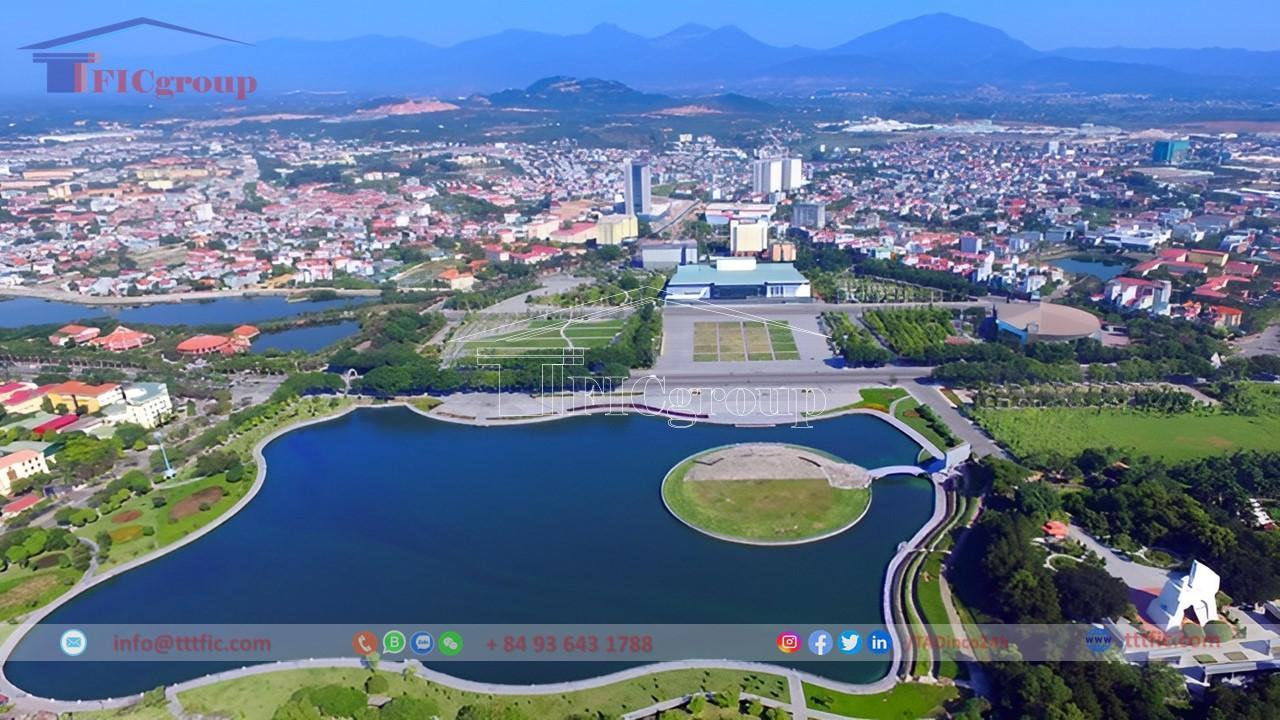
Education:
In recent years, the education sector in Vinh Phuc province has made remarkable progress, positioning itself as one of the provinces with the highest quality of education in the country. For three consecutive years (2012, 2013, and 2014), Vinh Phuc ranked first nationwide in terms of the average scores in the university entrance examination. In 2013, Vinh Phuc students won a silver medal in the International Mathematics Olympiad, a bronze medal in the International Biology Olympiad, and 49 students received prizes in the national excellent student competition.
In 2014, Vinh Phuc students ranked sixth in the country with 67 prizes in the national excellent student competition, further affirming their position as the top province in terms of the average scores in the university entrance examination.
Higher education institutions in Vinh Phuc include:
- Vinh Yen University of Transport Technology
- Hanoi Pedagogical University 2
- Hanoi Architectural University (Phuc Yen campus)
- Trung Vuong University
- Armor and Tank Officers School
- Military Technical Academy (Vinh Yen campus)
- Vinh Phuc Industrial and Commercial College
- Vinh Phuc Economic and Technical College
- Vinh Phuc College (formerly Vinh Phuc Vocational College)
- Vinh Phuc Vocational College FB
- Agricultural Machinery Vocational College
- Vietnam-Soviet Vocational College No. 1
- Vinh Phuc Technical College
- Vinh Phuc Health Vocational College
- Intermediate level programs within Vinh Phuc Economic and Technical College
- Intermediate level programs within Vinh Phuc Pedagogical College
- BQP Vocational College No. 2.
Healthcare:
Vinh Phuc’s healthcare milestones:
In 1997, Vinh Phuc had 4.6 doctors per 10,000 people and 8.1% of medical stations had doctors.
By 2012, the doctor-to-population ratio reached 7.5 doctors per 10,000 people, with 87.6% of medical stations having doctors. The average number of hospital beds was 24 per 10,000 people.
After 15 years since the province’s reestablishment, the healthcare sector has made significant progress in caring for and improving the health of the population. National healthcare programs have been effectively implemented. Currently, 132 out of 137 communes, wards, and towns in Vinh Phuc meet national healthcare standards, and 100% of medical stations have been solidly invested in.
The province now has 17 hospitals with a total of 3,090 beds, 37 regional clinics, and 139 commune/ward medical stations. A Singaporean company is investing in a large and modern healthcare hospital. The province is also investing in the construction of a new Provincial General Hospital and Maternity and Pediatrics Hospital, which will serve the regional area.
Vinh Phuc has 1 central-level hospital, 6 provincial hospitals, and 9 district-level hospitals, along with numerous clinics and medical centers. The following are the central-level and provincial-level hospitals (excluding private hospitals, district-level hospitals, clinics, and medical centers):
List of central-level and provincial-level hospitals:
- 74 Central Hospital (under the Ministry of Health).
- Vinh Phuc Provincial General Hospital.
- Phuc Yen District General Hospital.
- Military Hospital 109.
- Transport and Communications Hospital of Vinh Phuc Province (Ministry-level hospital).
- Lac Viet Friendship Hospital (private hospital).
- Vinh Phuc Traditional Medicine Hospital.
- Vinh Phuc Rehabilitation Hospital.
- Vinh Phuc Maternity and Pediatrics Hospital.
- Vinh Phuc Mental Hospital.

